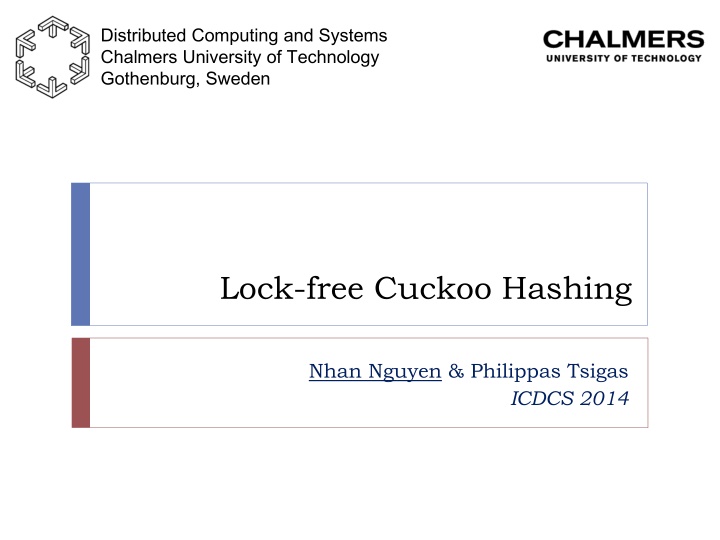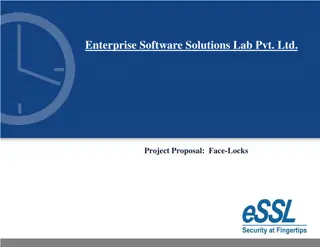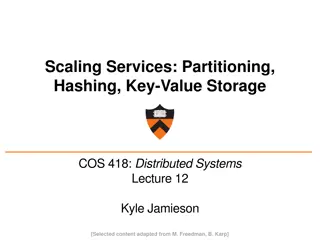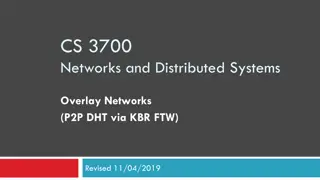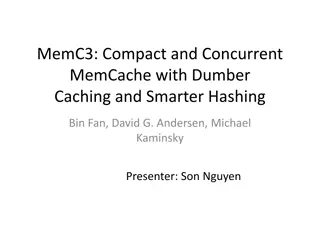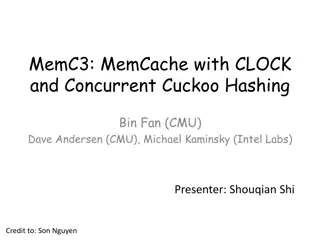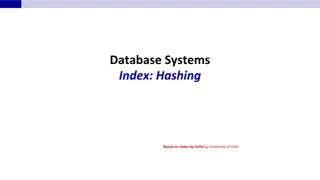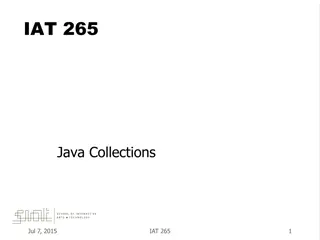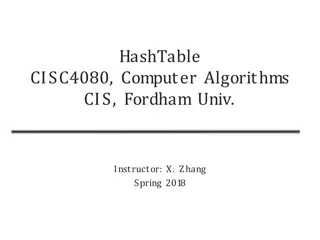Lock-free Cuckoo Hashing
Implementing a lock-free cuckoo hashing scheme for concurrent multicore systems, this research presents a high-performance hash table supporting multiple read/write operations simultaneously. The system guarantees progress without locking, achieving exceptional scalability in multicores and outperforming traditional hashing implementations.
Uploaded on Feb 20, 2025 | 0 Views
Download Presentation

Please find below an Image/Link to download the presentation.
The content on the website is provided AS IS for your information and personal use only. It may not be sold, licensed, or shared on other websites without obtaining consent from the author.If you encounter any issues during the download, it is possible that the publisher has removed the file from their server.
You are allowed to download the files provided on this website for personal or commercial use, subject to the condition that they are used lawfully. All files are the property of their respective owners.
The content on the website is provided AS IS for your information and personal use only. It may not be sold, licensed, or shared on other websites without obtaining consent from the author.
E N D
Presentation Transcript
Distributed Computing and Systems Chalmers University of Technology Gothenburg, Sweden Lock-free Cuckoo Hashing Nhan Nguyen & Philippas Tsigas ICDCS 2014
Our contributions: a concurrent hash table For shared memory multicores. It is based on cuckoo hashing. Support multi-readers/multi-writers: Query/ Insert/ Delete operations can be performed concurrently. Guarantee lock-free progress: At least one operation completed in a finite time. No locking, fault-tolerance. Achieve great performance and scalability in multicores: Outperform state-of-the-art chained and hopscotch hashing implementations. 2 Nhan D. Nguyen
Concurrent hash tables for multicores Hash table: a data structure mapping a key to a position in an array, using a hash function Efficient random accesses: O(1) search time. When multiple keys are hashed to one position: Conflict resolutions schemes: separate chaining, linear probing, cuckoo hashing, etc. Computational model: Shared memory multicores. Asynchrony: Processes running at different speeds, can be halted, delayed Multithreaded programs: simultaneous processes concurrently access shared data. 3 Nhan D. Nguyen
Concurrent hash tables - Design challenges Concurrency challenges: Concurrency between read and write operations Consistency and validity of data: atomicity? Scalability: Locking does not scale, especially under high contention. Resizing the table, concurrently with other operations. Desired properties for concurrent data structures Non-blocking progress guarantees. Fault tolerance 4 Nhan D. Nguyen
Concurrent hash tables - State-of-the-art Lock-free chained hashing [Michael-SPAA02] Each bucket points to a linked lists to hold conflicted keys. Lock-free ordered linked list is used. Resizable hash table based on split-ordered lists [Shalev-JACM06] Keys is stored in a special (i.e. split-ordered) linked list. Natural (and inexpensive) resize. Concurrent hopscotch [Herlihy-DISC08] Linear probing + cuckoo hashing. Limit the probing length within a constant k by using a displacement technique during insertion. And several others! 5 Nhan D. Nguyen
Outline Background Concurrent hash tables. Cuckoo hashing and its concurrent implementations. Our lock-free cuckoo hashing Design challenges and solutions. Performance evaluation Conclusions 6 Nhan D. Nguyen
Cuckoo hashing H1: X MOD 10 H2: X DIV 3 19 What is cuckoo hashing? [Pagh2004] Two hash functions two hash tables. A key is stored in either of the tables Conflict resolution: relocate existing keys to leave empty slot for the new key. Why cuckoo hashing? An simple yet efficient hashing scheme. Query needs two reads. Cache advantage. 9 11 2 1 7 Nhan D. Nguyen
Concurrent cuckoo hashing State-of-the-art Lock-based cuckoo hashing [Herlihy-TheArt] Lazy relocation: relocation only when the number of elements in a bucket is more than a predefined threshold (e.g. 4). An array of locks: need to acquire lock in any operation. MemC3: Concurrent cuckoo hashing for MemCache [BinFan-NDSI13] Single-writer/multi-readers Insert and relocation: Find cuckoo path. Move the hole backward: locking the slots. 8 Nhan D. Nguyen
Our cuckoo hashing design Support multi-readers/multi-writers. Highly concurrent Queries are not blocked by modification operations. Efficient relocations. Lock-freedom progress guarantee. First known lock-free cuckoo hashing! Note: we are not addressing bucketized cuckoo hashing nor the resizing issue. 9 Nhan D. Nguyen
Outline Background Concurrent hash tables. Cuckoo hashing and its concurrent implementations. Our lock-free cuckoo hashing Design challenges and solutions. Performance evaluation Conclusions 10 Nhan D. Nguyen
Concurrent cuckoo hashing Additional challenges Elements can be stored in two tables of a single data structure. Elements can be moved between tables. Challenges in concurrency control while guaranteeing: Consistency? Keys being modified are under movement. Correctness? Keys under movement might be invisible to query. Progress & efficiency: Locking or non-blocking? 11 Nhan D. Nguyen
Concurrency Issue 1: Query vs Relocation H2: X DIV 3 H1: X MOD 10 Thread 3 Thread 2 Thread 1 19 INS 1 Q 11? MOV 11 INS 9 In H1? MOV 11 In H2? 11 11 2 12 Nhan D. Nguyen 11?
Concurrency Issue 1: Query vs Relocation H2: X DIV 3 H1: X MOD 10 Thread 3 Thread 2 Thread 1 19 INS 1 Q 11? MOV 11 INS 9 In H1? MOV 11 Key exists! In H2? But QUERY returns FALSE? 11 2 13 Nhan D. Nguyen 11?
Solution 1: Two-round query H1: X MOD 10 H2: X DIV 3 Thread 3 Thread 2 Thread 1 19 INS 1 Q 11? MOV 11 INS 9 In H1? MOV 11 In H2? In H1? In H2? 11 2 14 Nhan D. Nguyen 11?
Concurrency Issue 1: more problems? H1: X MOD 10 H2: X DIV 3 Thread 3 Thread 2 Thread 1 19 INS 1 Q 11? MOV 11 INS 9 In H1? MOV 11 In H2? INS 21 MOV 11 INS 10 In H1? MOV 11 11 In H2? 11 2 15 Nhan D. Nguyen 11?
Solution 1: Two-round query + logical timestamp H1: X MOD 10 H2: X DIV 3 Thread 3 Thread 2 Thread 1 19 INS 1 Q 11? MOV 11 [+1] INS 9 In H1? t1 MOV 11 [+1] In H2? t2 INS 21 Restart the QUERY if: MOV 11 [+1] INS 10 In H1? t 1 t 1 t1 + 2 ANDt 2 t1 + 2 MOV 11 [+1] t2 In H2? t 2 t 1 t1+2 & t 2 t1+2 t1 11 2 11? 16 Nhan D. Nguyen
Concurrency Issue 2: Relocation of keys H1: X MOD 10 H2: X DIV 3 H1: X MOD 10 H2: X DIV 3 19 9 19 9 t3 19 19 19 t4 - Nestless keys - Chain of locks - Query is also being blocked 9 9 11 t2 9 11 11 11 1 11 1 t1 2 2 17 1 1 Nhan D. Nguyen
Solution 2: Fine-grained relocation process H1: X MOD 10 H2: X DIV 3 H1: X MOD 10 H2: X DIV 3 19 9 19 9 t3 19 No nestless key No chain of locks Query operations are not blocked 19 19 t4 - Nestless keys - Chain of locks - Query is also being blocked Relocation by a simple MOVE Use single-word Compare-And-Swap primitives Helping is needed for progress 9 9 11 t2 9 11 11 11 1 11 1 t1 2 2 18 1 1 18 Nhan D. Nguyen
Concurrency Issue 3: Concurrent Insertions H1: X MOD 10 H2: X DIV 3 Is duplication OK? With respect to the correctness! 19 W Depends: Query: No problem, decide on one! Insert: Does it need care? YES! Remove: more care, remove one or both? Y 11 11 X Z 2 Insert <11,X> Insert <11,Y> 19 Nhan D. Nguyen
Solution 3: Help deleting duplication H1: X MOD 10 H2: X DIV 3 Is duplication OK? 19 W Our proposal: Allow duplication Element in the first table is the valid one. QUERY to query: Return the first found <key, value> QUERY to modify: be aware of, and help delete one duplication, so that: Insert: have space for new or relocated keys. Delete: make sure a deleted key no longer exists. Y 11 11 X Z 2 Insert <11,X> Insert <11,Y> 20 Nhan D. Nguyen
Correctness and progress guarantee Correctness Linearizability: each operation takes affect at an instant point in time Proved by pointing out linearization points Progress guarantee: Lock-freedom There is always an operation completes after a finite number of steps See paper for the proof. 21 Nhan D. Nguyen
Outline Background Concurrent hash tables. Cuckoo hashing and its concurrent implementations. Our lock-free cuckoo hashing Design challenges and solutions. Performance evaluation Conclusions 22 Nhan D. Nguyen
Experimental setup Implementation C++ with GNU GCC 4.7 Experimental methods Micro benchmark: synthesized threads performing operations on a shared hash table. Platform: 2x8-core Intel Xeon with HyperThreading: 32 hardware threads. Linux kernel 3.0 Compared with: Hopscotch hashing [Herlihy-DISC08] Maybe the fastest! Lock-based chained hashing [Knuth-TheArt]. 23 Nhan D. Nguyen
Throughput Lock-free Cuckoo Lock-free Cuckoo 24 Nhan D. Nguyen
Cache behaviour 40% load factor; 90% insert, 5% insert, 5% remove 4 3 cach misses/op 2 1 0 4 8 12 16 20 24 28 32 Threads Cuckoo Hopscotch Chained 25 Nhan D. Nguyen
Outline Background Concurrent hash tables. Cuckoo hashing and its concurrent implementations. Lock-free cuckoo hashing Design challenges and solutions. Performance evaluation Conclusions 26 Nhan D. Nguyen
Conclusions We proposed an efficient concurrent hash table: Use cuckoo hashing technique. Support concurrency among all operations. Guarantee lock-freedom. Achieve great performance and scalability. Future improvements Resize Improve table density: Current: <50% density (~ cuckoo hashing). Using bucket: multiple elements in a table slot. 27 Nhan D. Nguyen
Questions? Thank you! Nhan Nguyen: nhann@chalmers.se / ndnhan@gmail.com Distributed Computing and Systems, DCS @Chalmers http://www.cse.chalmers.se/research/group/dcs/ 28 Nhan D. Nguyen
